DFI LANParty UT ICFX3200-T2R: ATI's, err, AMD's RD600 finally arrives
by Gary Key on December 16, 2006 7:00 PM EST- Posted in
- Motherboards
Standard Gaming Performance
As usual, gaming performance was tested with a variety of current games. We ran benchmarks with our standard 1280x1024 resolution without antialiasing enabled (and generally without anisotropic filtering, though that varies by game). Given the number of users that run 19 inch LCDs these days, 1280x1024 represents one of the most commonly used resolutions. We could certainly increase the amount of eye candy being displayed in most of the games, but as this is a motherboard benchmark we aren't particularly interested in maxing out the graphics cards for all tests.
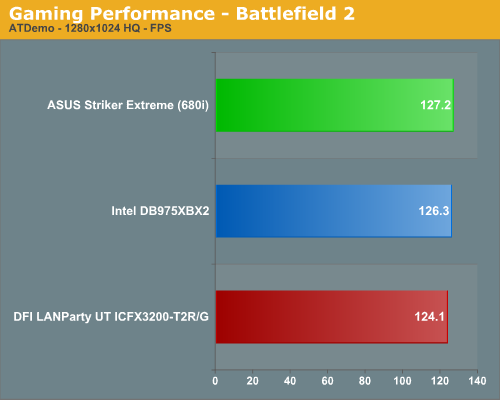
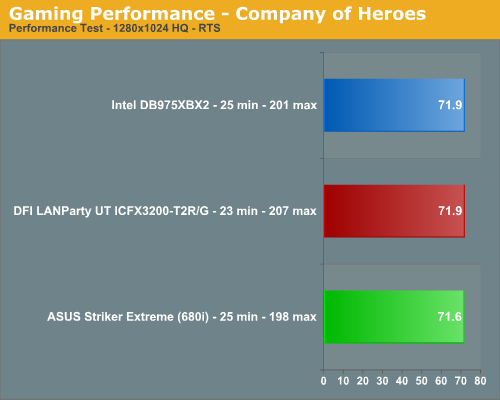


As we commented previously, gaming benchmarks seemed to favor the RD600 although our Battlefield 2 scores are puzzling considering the almost three percent drop in performance at these settings. Battlefield 2 at this time is fairly sensitive to CPU speed and memory timing improvements which did occur as we changed either our CPU speed or optimized our memory settings, but the board never caught the 975X or 680i at the same settings. However, very few people would ever notice a difference between the various motherboards while gaming although Quake 4 seemed more fluid on the DFI board during online game play across our LAN. We will be testing the DFI board with the GeForce 8800GTX to see how well it performs but at this time most games seem to favor the RD600 while Battlefield 2 does not, at least in single card testing.
High-Resolution Gaming Performance
For high-quality gaming performance, we also tested at 1600x1200 with 4xAA/8xAF. As just about anyone familiar with current games can tell you, benchmarking with a single high-end graphics card at those stressful settings will make almost any recent game GPU limited. In fact, several of the most recently released games such as Oblivion can be GPU limited at this setting even with CrossFire or SLI setups. Our test results are limited to two games for now, but we will provide expanded coverage in our next article, including Intel P965 and 1920x1200 results.
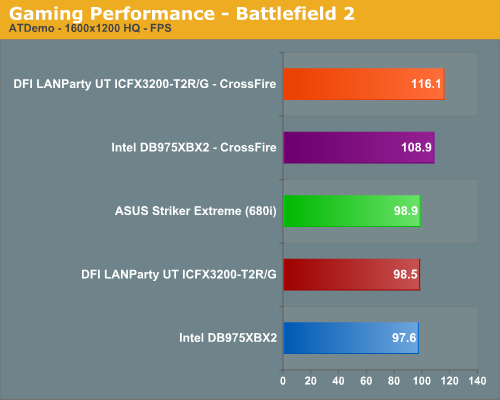
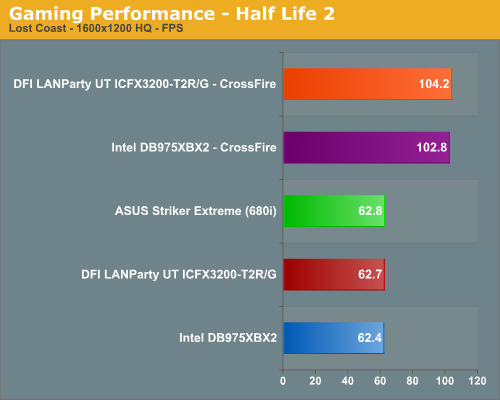
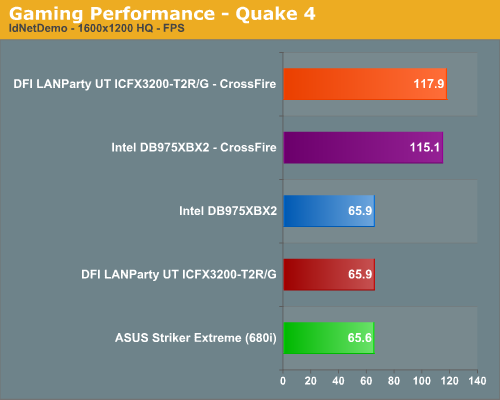
If you're serious about gaming at higher resolutions with all the eye candy enabled, you will most certainly want to run a multi-GPU configuration. Looking specifically at the DFI board, its relative positioning has improved greatly when playing Battlefield 2 under CrossFire along with improvements in Half Life 2: Lost Coast. It appears the optimizations that ATI built into their chipsets for CrossFire performance are indeed noticeable at the higher resolutions. Our 1280x1024 CrossFire testing yielded very few differences but the performance gap between the 975X and RD600 widened as we increased our resolution and AA/AF settings. We also noticed this same behavior in other games that we tested including Company of Heroes and F.E.A.R.
The only issue with X1950 CrossFire now is that NVIDIA's 8800 GTS/GTX cards can provide substantially higher performance, particularly in SLI configurations. As usual, SLI is not officially supported by NVIDIA on non-NVIDIA chipsets, and likewise you can't run CrossFire on NVIDIA chipsets. That means that 8800 GTX SLI and a 680i board would currently be a faster gaming solution, but AMD will counter with R600 early next year. Whether or not they can reclaim the performance crown remains to be seen, so if you're not in any hurry to spend a lot of money on upgrading it might be best to wait and see what happens.
As usual, gaming performance was tested with a variety of current games. We ran benchmarks with our standard 1280x1024 resolution without antialiasing enabled (and generally without anisotropic filtering, though that varies by game). Given the number of users that run 19 inch LCDs these days, 1280x1024 represents one of the most commonly used resolutions. We could certainly increase the amount of eye candy being displayed in most of the games, but as this is a motherboard benchmark we aren't particularly interested in maxing out the graphics cards for all tests.




As we commented previously, gaming benchmarks seemed to favor the RD600 although our Battlefield 2 scores are puzzling considering the almost three percent drop in performance at these settings. Battlefield 2 at this time is fairly sensitive to CPU speed and memory timing improvements which did occur as we changed either our CPU speed or optimized our memory settings, but the board never caught the 975X or 680i at the same settings. However, very few people would ever notice a difference between the various motherboards while gaming although Quake 4 seemed more fluid on the DFI board during online game play across our LAN. We will be testing the DFI board with the GeForce 8800GTX to see how well it performs but at this time most games seem to favor the RD600 while Battlefield 2 does not, at least in single card testing.
High-Resolution Gaming Performance
For high-quality gaming performance, we also tested at 1600x1200 with 4xAA/8xAF. As just about anyone familiar with current games can tell you, benchmarking with a single high-end graphics card at those stressful settings will make almost any recent game GPU limited. In fact, several of the most recently released games such as Oblivion can be GPU limited at this setting even with CrossFire or SLI setups. Our test results are limited to two games for now, but we will provide expanded coverage in our next article, including Intel P965 and 1920x1200 results.



If you're serious about gaming at higher resolutions with all the eye candy enabled, you will most certainly want to run a multi-GPU configuration. Looking specifically at the DFI board, its relative positioning has improved greatly when playing Battlefield 2 under CrossFire along with improvements in Half Life 2: Lost Coast. It appears the optimizations that ATI built into their chipsets for CrossFire performance are indeed noticeable at the higher resolutions. Our 1280x1024 CrossFire testing yielded very few differences but the performance gap between the 975X and RD600 widened as we increased our resolution and AA/AF settings. We also noticed this same behavior in other games that we tested including Company of Heroes and F.E.A.R.
The only issue with X1950 CrossFire now is that NVIDIA's 8800 GTS/GTX cards can provide substantially higher performance, particularly in SLI configurations. As usual, SLI is not officially supported by NVIDIA on non-NVIDIA chipsets, and likewise you can't run CrossFire on NVIDIA chipsets. That means that 8800 GTX SLI and a 680i board would currently be a faster gaming solution, but AMD will counter with R600 early next year. Whether or not they can reclaim the performance crown remains to be seen, so if you're not in any hurry to spend a lot of money on upgrading it might be best to wait and see what happens.










42 Comments
View All Comments
RichUK - Monday, December 18, 2006 - link
You seem to have missed the focus point of my initial comment. I didn’t insist DFI implement an active cooling solution, rather a more adequate solution.Atleast you somewhat agree with my original immediate argument:
I never wanted an active cooling solution, never. However, I had hoped DFI would implement a solution that would exceed the requirements for cooling this chipset. Hopefully this point will be moot when I receive my board, and when I receive my board I won’t have to do any sort of cooling modding.
yacoub - Saturday, December 16, 2006 - link
Actually most folks will be extremely pleased to see DFI finally move away from the godawful mobo chipset mini-fans. Those dinky fans are noisy and generally die very young . They cause more trouble than they're worth (hence why you see the vast majority of motherboards today have moved to passive cooling / heatpipe setups). Not only is a heatpipe setup quieter, it's also much lower maintenance.